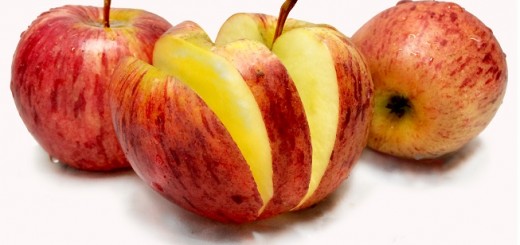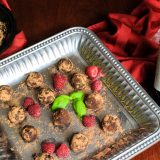Heirloom Melons – Refreshingly Sweet Seasonal Treats
Heirloom Melons – Refreshingly Sweet Seasonal Treats
By Robbie Sigona
As we move into the later part of summer, more melons make their way to our stores. Not just more watermelon, cantaloupe and honeydew, but all the refreshingly sweet, juicy and unique heirloom melons start to hit their peak, including the delicate and sweet Sharlyn melon, or the Crane melon with its aromatic, light orange flesh that’s sweet and juicy.
Heirloom melons are varieties that have been grown without being tampered with or cross-bred from generation to generation for at least 50 years. The revival of heirloom products, such as certain stone fruits, tomatoes and melons, has been a gift to us that we can now enjoy these very perishable gems. We’re so thankful for our local farmers, such as Don Smith, a family farmer with Turlock Fruit Company in Turlock, Calif., and Phil Foster of Pinnacle Organic in Hollister, Calif. They have have continued to cultivate heirlooms over the years, preserving another little piece of our past.

We get some organic heirloom melons from Phil Foster, a farmer in Hollister, Calif. who we've worked with for 15 years.
We’ve worked with Phil Foster for about 15 years. Phil and Katherine Foster farm 250 acres of C.C.O.F. and I.F.O.A.M. certified organic vegetables, melons and fruit on two ranches near San Juan Bautista and Hollister. In addition to the organic, heirloom melons, the Fosters provide us with organic heirloom tomatoes and organic greens, which are available just about year round. Phil has incorporated several sustainable practices into his farming techniques to help protect both the crops and environment. For example, they work to build the soil using compost made right there on the farm. They also practice integrated pest management to help minimize the need for any sprays (even though all sprays are organic) whenever possible as biological control is always their primary goal.
I know I’ve said this before, but I’ll say it again: I’m continually wowed by the intense, irreplaceable flavors of a locally grown melon on a hot summer day. Melons are the perfect antidote for high temperatures. Melons help keep body temperatures lower than other foods that take longer to digest. As they’re made up almost entirely of water, they help keep the body cooler from the start; they’re filling and refreshing without being heavy on calories either. Also, melons are full of electrolytes, minerals and vitamins which help sustain one’s body in hot weather.
The Haogen melon, with its mildly spicy-sweet green flesh and strong floral fragrance, is a favorite in the Sigona family, but it’s hard to find. The Haogen is an ugly, delicate melon that usually bruises on its way to the market so they aren’t popular amongst customers. Not many people grow them anymore, but we just received a shipment of organic Haogens today. They’re so fragrant you can smell them across the room! Hurry in to get one, they won’t last long.
We also expect to bring in a few Crane melons later this month. The Crane melon was developed in Santa Rosa, Calif. the early 1900s by Oliver Crane. It’s a hybrid of several melons, including a Japanese melon, a Persian melon and an Ambrosia melon. Sweet and juicy Crane melons are round like soccer balls and have an aromatic, light orange flesh. The Crane family is still cultivating the Crane melon and for more than 80 years and six generations, they still operate out of the Crane Melon Barn in Santa Rosa.
We always encourage our customers to support local farmers who grow pieces of the past. Following is information about some of the heirloom melons we carry – there are more varieties in our stores!
–
–
The Sharlyn melon has a soft, white flesh that is delicate and sweet. The melon itself is more of an oblong shape with a thin orange-red rind characterized with thin, spread out netting. This melon tends to have a loose cavity, meaning that when its cut it’ll have loose seeds, whereas seeds of a cantaloupe or honeydew remain in place.
–
–
–
The Casaba melon is hard to miss because of its bright yellow, wrinkly skin and round, walnut-like shape. Its light green, refreshing flesh is very juicy and mildly sweet.
–
–
–
–
The Cranshaw melon has a beautiful amber or salmon-colored flesh that’s soft, smooth and sweet. The outside is smooth and yellow, and turns a little golden when ripe. Their flavor and pleasant aroma are out-of-this-world. This melon originated as the Crenshaw, a super sweet, old fashioned variety that is no longer grown.
–
–
–
–
The Haogen melon, a Hungarian heirloom, is a favorite in the Sigona family. It’s so sweetly fragrant you can smell it across the room! The Haogen is a somewhat ugly melon in appearance, with its ribbed, dark green and orange-brown rind. However, its green flesh is spicy-sweet, smooth and juicy.
–
–
–
–
The Ambrosia melon has a orange-tan colored skin with a hint of green, similar to a cantaloupe. It has a very sweet, tender and pale peachy-orange colored flesh and a pleasant floral fragrance and flavor.
–
–
–
The Crane melon was developed in Santa Rosa, Calif. the early 1900s by Oliver Crane. It’s a hybrid product of several melons, including a Japanese melon, a white melon, a Persian melon and an Ambrosia melon. Crane melons are round with very aromatic light orange flesh that’s sweet and juicy. They’re generally available in late September.
–
–
–
–
Charentais melons have smooth grey-green rinds and a very fragrant orange flesh. A ripened Charentais gives off a refreshing, delicious aroma. They are said to have originated in Cavaillon, France, and are sometimes sold under this name.
–
–
–
–
The Tuscan melon, also known as an heirloom style cantaloupe, has a firm, dense flesh which stands up on its own and in salads. It pairs well with stronger flavors and retains its own juices. Tuscan melons are an old-fashioned heirloom variety with cantaloupe-colored flesh and pronounced ribs on the outside. The Tuscan melon is done for the season.
–
–
–
Galia melons are highly aromatic and have pale green flesh that’s packed with juice. Galias are incredibly sweet with a texture similar to a watermelon. They have a telltale dark golden colored ring under the netting when they’re ripe. The Galia is done for the season.



















